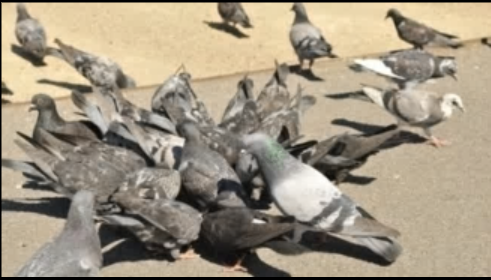
用鸽子替代儿童检测血铅
Pigeon Pb Proxies Could Cut Kids' Blood Tests
用鸽子替代儿童检测血铅
In neighborhoods where kids have an increased chance of exposure to toxic lead, pigeons also have higher blood lead levels—making the birds potential proxies for risk assessment.
在那些小孩子更有可能接触铅的社区,附近鸽子的血液中的铅含量也较高——这预示着鸟儿可以成为潜在的风险评估指标。
撰文/播音:贾森 G·戈德曼 (Jason G. Goldman)
翻译:杨枭
审校:吴非
Pigeons. Ever since humans established permanent agricultural settlements, we’ve lived side-by-side with the birds—or, as some people call them, rats with wings. They walk on our sidewalks, roost on our buildings, and eat our leftovers. But soon pigeons may help us identify risks to public health.
自从人类建立永久的农业定居点之后,我们便与鸟儿(或者某些人所说的带翅膀的老鼠)并肩生活在一起。它们在我们的道路上散步,在我们的建筑上筑巢,还会以我们的残羹为食。但在不久的将来,鸽子还可能帮助我们确认公共健康的风险。
"What we're doing here in my lab is we're assessing how we can use something that's been considered a pest that people actively try to exterminate: the pigeon. How can we use it to better the environment for not only ourselves but for pigeons and for other wildlife?"
“鸽子在很多人眼中是亟待消灭的有害动物,但在我的实验室里,我们在评估如果利用它们。我们应如何利用鸽子来改善人类、鸽子以及其他野生动物的环境呢?”
U.C. Davis neurobiologist Rebecca Calisi. She looked at lead levels in blood samples from more than 800 injured pigeons brought to a New York City wildlife rehabilitation center. And she compared those to lead levels in blood samples collected from children by the New York City Department of Health in routine screening efforts. The results were published in the journal Chemosphere. [Fayme Cai and Rebecca M. Calisi.Seasons and neighborhoods of high lead toxicity in New York City: The feral pigeon as a bioindicator]
丽贝卡·卡利西(Rebecca Calisi)是加利福尼亚大学戴维斯分校的神经生物学家,她检测了超过800只来自纽约野生动物康复中心的受伤的鸽子血样中的铅浓度,并与纽约市健康中心例行检查的儿童血样中的铅浓度进行了对比。该研究结果发表在了Chemosphere期刊上。
"The neighborhoods where children have high rates of lead toxicity, that's where we saw pigeons with high blood lead levels…so this is a proof of concept kind of project."
“在儿童铅中毒比率高的社区,那里鸽子的血铅浓度也较高。所以,这可以成为一个概念型课题。”
Most pigeons will live out their lives within just two kilometers of the place they hatched, so the birds may be able to help researchers develop a detailed map of the risk of toxic lead exposure.
大多数鸽子会在距离巢穴两千米的范围内活动,因此,鸟儿可以帮助研究者描绘详细的铅扩散风险图。
In people, especially kids, lead exposure can affect intelligence, brain development, social skills and memory. Having demonstrated that pigeons can pinpoint areas with high lead contamination, Calisi thinks that the birds can help researchers zero in on other potential environmental hazards as well.
接触铅会影响人的智力、大脑发育、社交技能和记忆力,对于儿童尤为严重。研究已经证实,鸽子可以确定高浓度铅污染区域,卡利西认为它们还能确定其他潜在的环境风险。
"The thing is, we don't know what to test for right now. We know to test for lead, but what about certain pesticides? Or fire retardants are a big problem these days. We're not sure what the problems are. So instead of drawing a ton of blood from children and putting them through all these tests, why not use an animal that shares our environment, the pigeon, and test for a whole suite of different potential harmful pollutants?"
“当今的问题是我们不知道该检验什么。虽然我们知道应该检测铅含量,但某些杀虫剂是否需要检验呢?还有,最近阻燃剂也是个大麻烦。我们并不确定高水平血铅的症结在哪里。因此,相比于从儿童体内抽大量血液,何不利用与我们分享环境的鸽子来检验全套的潜在有害污染物呢?”
So rather than dismissing them as rats with wings, why not think of them as…lab rats with wings?
所以,相比于把它们作为带翅膀的老鼠驱逐,还不如考虑将它们看作带翅膀的实验小鼠吧?
未经书面许可任何人不得复制或镜像
京ICP备11000850号-1
 京公网安备11010502039775号
京公网安备11010502039775号 信息网络传播视听节目许可证0111611号
国家科技基础条件平台

















